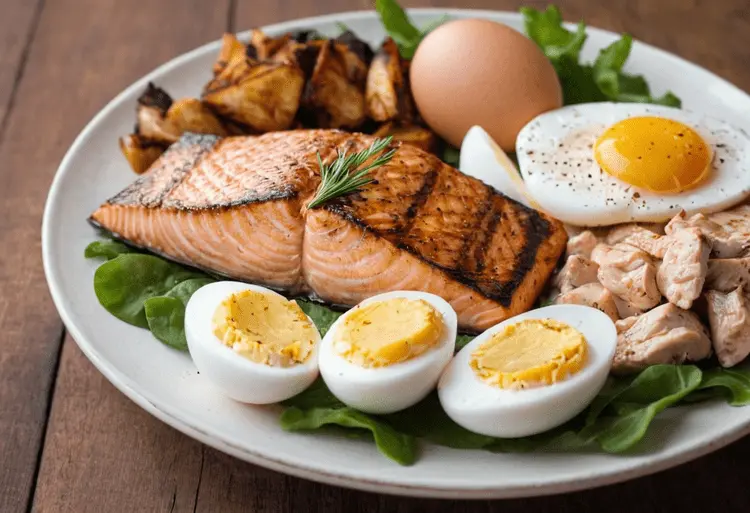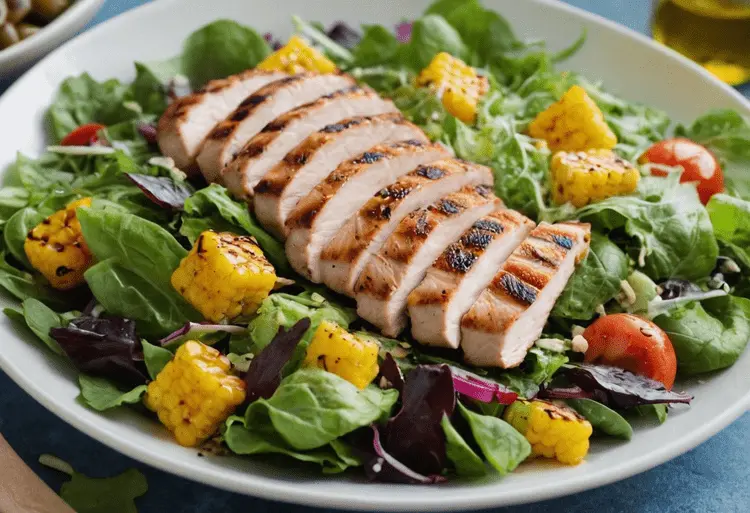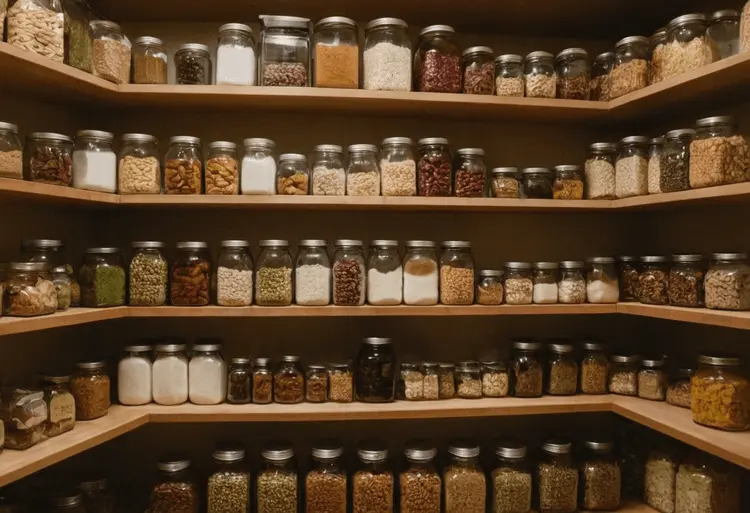Paleo Diet: Tired of fad diets that leave you feeling deprived and frustrated? The modern Western diet, packed with processed foods and refined sugars, may be the root cause of your fatigue, weight gain, and chronic health issues.
Imagine a simpler time, when our ancestors thrived on a diet rich in whole, nutrient-dense foods. The Paleo diet, also known as the Paleolithic or caveman diet, offers a refreshing alternative, focusing on foods like lean meats, fish, fruits, vegetables, nuts, and seeds.
Discover the secrets of ancestral eating with our comprehensive Paleo Diet Guide. Learn how to create a meal plan tailored to your needs, understand the science-backed benefits of the Paleo diet, and navigate potential drawbacks with confidence.
This is your roadmap to a healthier, more vibrant you!
Paleo Diet at a Glance
- Paleo: Ancestral eating
- Whole, unprocessed foods
- Benefits: weight loss, better health
- Drawbacks: restrictive, costly
- Consult experts before starting
Table of contents
Introduction to the Paleo Diet

What is the Paleo Diet?
Tired of fad diets that leave you feeling deprived and hangry? Craving a way of eating that nourishes your body and honors its ancient roots? The Paleo diet may be your answer.
But what exactly is the Paleo diet? In a nutshell, it’s a nutritional approach that harkens back to our hunter-gatherer ancestors. It centers around whole, unprocessed foods that our bodies are naturally adapted to thrive on.
Think vibrant fruits and vegetables, lean meats, fish, nuts, and seeds.
The Paleo diet isn’t just about what to eat, though. It’s a lifestyle shift that prioritizes your well-being. Want to learn more about the potential health benefits and drawbacks? Check out this detailed analysis from Harvard’s T.H.Chan School of Public Health
The Philosophy Behind Paleo: Embracing Your Inner Caveperson
Ever wonder if modern diets are out of sync with our genetic makeup? The Paleo diet operates on the idea that our bodies haven’t fully adapted to the processed foods and grains that dominate our grocery shelves.
By ditching these modern additions and embracing Paleo-approved foods, you may be able to reduce inflammation, improve digestion, and even boost your energy levels.
Busting Paleo Myths: Separating Fact from Fiction
Despite its growing popularity, the Paleo diet is often misunderstood. Some folks believe it’s overly restrictive or lacks scientific backing. However, a wealth of research supports its potential benefits.
And while it does eliminate certain food groups, the Paleo diet still offers a wide variety of delicious and satisfying options.
Have you tried the Paleo diet? We’d love to hear about your experiences! Share your thoughts in the comments below or tag us on social media using #PaleoJourney.
Eating Paleo is great, but are you absorbing all those nutrients? Maximize your results with the next step in ancestral living – optimizing protein absorption.
The Science Behind the Paleo Diet: A Deeper Dive
Ever wondered why the Paleo diet emphasizes certain foods and excludes others? Let’s unravel the scientific threads woven into this ancestral eating approach.
The Evolutionary Angle: Are We Out of Sync?
Our bodies evolved over millions of years,adapting to a hunter-gatherer lifestyle. The Paleo diet suggests modern diets, rich in processed foods and grains, might not align with our genetic blueprint.
This evolutionary mismatch hypothesis proposes that our bodies may thrive on foods our ancestors ate.
- Did you know?Studies on modern hunter-gatherer societies like the Hadza reveal remarkably low rates of chronic diseases like heart disease and diabetes. Could their Paleo-like diet be a contributing factor? The Harvard T.H. Chan School of Public Health delves into these potential benefits.
- The Paleo diet focuses on whole, unprocessed foods that mirror our ancestral eating patterns.
Nutrients: What Does Paleo Pack?
The Paleo diet is naturally high in:
- Protein: From lean meats, fish, and eggs, essential for muscle growth and repair.
- Fiber: Abundant in fruits and vegetables, promoting gut health and satiety.
- Healthy Fats: Found in avocados, nuts, and seeds, crucial for brain function and hormone balance.
- Vitamins and Minerals: Plentiful in the diverse array of fruits and vegetables.
It’s also typically lower in:
- Refined Carbohydrates: Like those found in processed foods and grains, which can cause blood sugar spikes.
- Sodium: Often excessive in modern diets, potentially contributing to high blood pressure.
Wondering how this nutritional profile stacks up against weight loss goals? Learn more about the Paleo diet’s potential impact on weight management.
But here’s the thing:
The Paleo diet isn’t a one-size-fits-all approach. It’s about understanding your body and making informed choices.
Foods to Eat and Avoid on the Paleo Diet

Ever wondered what a caveman’s grocery list looked like? Well, the Paleo diet isn’t about gnawing on bones or foraging for berries. It’s about nourishing your body with whole, unprocessed foods that your ancestors thrived on.
Ready to channel your inner hunter-gatherer? Let’s dive into the Paleo-approved menu!
Fueling Your Body: Paleo-Approved Foods
The Paleo diet is a vibrant tapestry of flavors and textures, celebrating nature’s bounty. Imagine a plate overflowing with:
- Lean Meats: Think grass-fed beef, free-range poultry, and wild-caught fish. These protein powerhouses provide essential amino acids for muscle repair and energy.
- Fruits and Veggies: A rainbow of fresh produce bursting with vitamins, minerals, and antioxidants. Opt for low-glycemic options like berries, leafy greens, and cruciferous vegetables.
Ever wondered about the potential benefits of the Paleo diet? Learn more about the potential health benefits and drawbacks from Harvard’s T.H. Chan School of Public Health.
- Nuts and Seeds: A satisfying crunch packed with healthy fats, protein, and fiber. Almonds, walnuts, chia seeds, and flaxseeds are excellent choices.
- Healthy Fats: Avocados, olive oil, coconut oil… these nourishing fats support heart health, brain function, and hormone balance.
- Eggs: Nature’s perfect protein package, offering essential nutrients like choline and vitamin D.
- Seafood: Fish and shellfish are loaded with omega-3 fatty acids, known for their anti-inflammatory properties and heart-protective benefits.
Curious about the nutritional breakdown of these foods? The Paleo diet is naturally high in protein, moderate in fat, and low in carbohydrates. It’s a nutrient-dense way of eating that can help you feel energized and satisfied.
Foods to Bid Farewell: Off the Paleo Menu
Now, let’s explore what’s not invited to the Paleo party:
- Grains: Wheat, rice, corn, and other grains are off-limits due to their potential to trigger inflammation and digestive issues.
- Legumes: Beans, lentils, and peanuts are excluded due to their lectins and phytins, which can interfere with nutrient absorption.
- Dairy: Milk, cheese, and yogurt are a no-go due to lactose, a sugar that many people have difficulty digesting.
- Processed Foods: Say goodbye to sugary snacks, refined oils, artificial sweeteners, and anything that comes in a box or bag.
Remember, the Paleo diet is a journey, not a destination. It’s about discovering what fuels your body best and feeling your absolute best.
How to Start and Succeed on the Paleo Diet
Ready to embrace the vibrant health benefits of the Paleo diet? Let’s dive into a step-by-step roadmap to make your transition smooth, enjoyable, and sustainable. Remember, this is a journey, not a race – and I’m here to guide you every step of the way!
Step 1: Clean Out Your Kitchen
The first step to a successful Paleo journey? Declutter your kitchen. Say goodbye to processed foods, grains, legumes, and sugary treats. It’s time to make space for the nourishing, whole foods that will fuel your body.
Step 2: Stock Up on Paleo Staples
Fill your pantry and fridge with Paleo-approved ingredients. Think vibrant fruits and vegetables, lean meats, fish, eggs, nuts, seeds, and healthy fats like avocado and olive oil. Need inspiration? Check out this detailed list of Paleo foods to eat and avoid.
Step 3: Plan Your Paleo Meals
Ever heard the saying, “Fail to plan, plan to fail”? This holds true for the Paleo diet, too. By planning your meals in advance, you’ll avoid impulsive decisions and ensure you have delicious, nutritious options on hand.
Step 4: Embrace Meal Prep
Meal prepping is a game-changer for busy people on the go. Set aside a few hours each week to cook large batches of Paleo-friendly dishes. This way, you’ll always have healthy meals ready to grab and go.
Step 5: Get Creative in the Kitchen
The Paleo diet is anything but boring! Experiment with new recipes, flavors, and cooking techniques. You’ll be surprised at the incredible variety of delicious meals you can create with simple, whole ingredients.
Step 6: Don’t Be Afraid to Adapt
Remember, the Paleo diet is not one-size-fits-all. Feel free to personalize it to your individual needs and preferences. Explore variations like the Autoimmune Protocol (AIP) if you have specific health concerns. Check out the Mayo Clinic’s guide on this diet for more information.
Step 7: Listen to Your Body
Your body is your best guide. Pay attention to how different foods make you feel. Notice any changes in your energy levels, digestion, or overall well-being. This will help you fine-tune your Paleo approach and make choices that support your unique needs.
Step 8: Stay Hydrated
Water is essential for optimal health, especially when you’re on the Paleo diet. Aim to drink plenty of water throughout the day to stay hydrated, support digestion, and flush out toxins.
Step 9: Get Moving
While the Paleo diet focuses on nutrition, exercise is a crucial component of a healthy lifestyle. Find activities you enjoy, whether it’s dancing, hiking, biking, or lifting weights. The key is to move your body regularly and have fun doing it.
Step 10: Be Patient and Persistent
Remember, change takes time. Be patient with yourself as you adjust to the Paleo lifestyle. There will be challenges along the way, but don’t give up! With persistence and determination, you can achieve your health goals and thrive on this diet.
Nutritional Information for the Health-Conscious
The Paleo diet is naturally rich in nutrients, thanks to its focus on whole, unprocessed foods. You’ll enjoy a healthy dose of protein, fiber, vitamins, and minerals, while avoiding refined sugars and processed ingredients that can sabotage your health. To learn more about the potential health benefits and drawbacks of the Paleo diet, check out this insightful article from Harvard’s T.H. Chan School of Public Health.
Share Your Paleo Journey with Us!
I’m excited to hear about your Paleo journey! Leave a comment below or tag me on social media to share your experiences, tips, and favorite recipes. Let’s create a supportive community and inspire each other to thrive on the Paleo diet.
Embarking on Your Paleo Journey

The Paleo diet isn’t just a trend; it’s a lifestyle shift with potential for profound impact on your well-being. But is it the right fit for you?
Remember, everyone is unique, and the Paleo diet offers a framework, not a strict rulebook. Consult with your doctor or a registered dietitian to tailor it to your needs.
To get the most out of this lifestyle, prioritize high-quality, nutrient-rich foods. Lean meats, fish, and fresh produce should be your staples. This isn’t just about what you don’t eat (processed foods, grains, legumes)
But about the abundance of nourishing choices you do have. You can also learn about the potential health benefits and drawbacks of this diet from Harvard’s T.H. Chan School of Public Health.
Eating Paleo but craving a juicy steak and a handful of berries? You’re not alone! Discover if the meat-heavy, fruit-focused trend is a nutritional powerhouse or a potential health hazard in our deep dive: “The Meat and Fruit Diet: Trend or Trouble?
Your Burning Questions About the Paleo Diet
Ever wondered if the Paleo diet is right for you? Let’s tackle some common questions and uncover the truth behind this ancestral eating plan.
This diet focuses on whole, unprocessed foods like lean meats, fish, fruits, vegetables, nuts, and seeds.
Foods like grains, legumes, dairy, processed foods, refined sugars, and artificial sweeteners are avoided on the this diet.
Potentially restrictive, may lack certain nutrients (e.g., calcium, vitamin D), can be expensive, lacks long-term research, and may not be suitable for everyone.
Both diets emphasize whole foods and limit processed items. Paleo focuses on lean protein and healthy fats, while keto prioritizes high fat and very low carb intake to induce ketosis.
Consult your doctor first, especially if you have health conditions. Mayo Clinic provides insights on the potential risks.
Absolutely! Leafy greens, nuts, seeds, and fortified foods are excellent sources. this Diet for Weight Loss offers more guidance.
Not necessarily. Focus on whole, unprocessed foods like seasonal produce and affordable protein sources.
It’s challenging due to the emphasis on animal protein, but modifications are possible.
Weight loss is possible due to healthier choices, but focus on overall health, not just weight loss.
Leave a comment below, connect with us on social media, or consult a registered dietitian. Let’s embrace the Paleo lifestyle together!